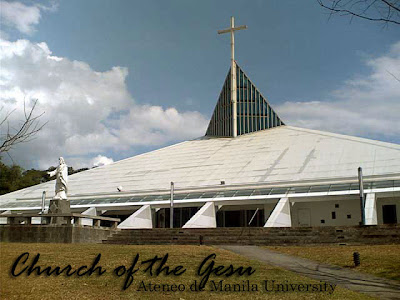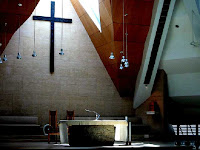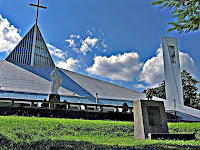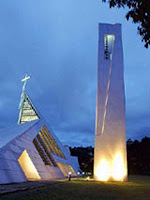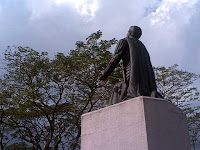
The University of the Philippines, Diliman has been a big part of my life. I spent nine years in U.P. as a student, finishing three degrees. And now, I'm a member of the faculty, teaching tourism courses at the Asian Institute of Tourism.
And U.P Diliman food has definitely been a big part of all those years. I was a dormer for close to four years and had my share of isaw, fishballs and dirty ice cream, as well as food from the U.P. Shopping Center, U.P. Coop or aristocart when I missed my meals at the dorm. Some of the restaurants we used to eat at have moved to other places like Mommy Thai.
Contrary to popular notion, U.P. Diliman is not just about fishballs, isaw and dirty ice cream. I spent one afternoon and evening after class roaming around U.P. with friends and even celebrities to rediscover the food I've always enjoyed. So here's a list of things and places to eat in U.P. Diliman:

1. Beach House Canteen
This small hut beside the U.P Main Library and Sunken Garden is already an institution. They are most known for the Pork Barbecue (Php25 a stick), Pork Chop (Php50 a serving) and other grilled dishes. Beach House Canteen is open from 9 a.m. to 3 p.m. If you are looking for affordable and delicious barbecue, Beach House is the place to get it.

2. R.O.C. (Restaurant of Choice)
This is the newest restaurant in U.P. Diliman located at the Ang Bahay ng Alumni. It's my favorite hang-out because of its great food and free WiFi Internet. R.O.C. is open daily from 10 a.m. to 9 p.m.
Among my favorite dishes at R.O.C. is the R.O.C. Burger, 100% quarter pound beef patty, aioli, lettuce, tomatoes and onions served in a sesame bun (Php158), Garlic Chicken, boneless chicken thighs, ROCs herb-garlic sauce, garlic rice and chefs veggies (Php185), Quattro Funghi, four-mushroom melange, garlic ream sauce and linguine (Php166), and the Bourbon Burger, 100% quarter pound beef patty, aioli, Bourbon glazed onions, lettuce and tomatoes served in a sesame bun (Php175). Also try out the Buco Sherbert (Php78) which is among their best-sellers.

I had lunch there with former U.P. Diliman USC chairperson Kris Ablan (few people know he was a FAMAS-nominated child actor who went by the screen name Kris Banal) and dinner with blogger Anton Diaz, and former actress Paula Peralejo of Tabing Ilog fame and a U.P. Diliman magna cum laude graduate herself. Being a vegetarian, Paula tried out the Margherita Panniza (Php228) and Quattro Funghi.

3. The Chocolate Kiss Cafe
This restaurant opened at the Ang Bahay ng Alumni when I was a freshman and was a regular lunch or afternoon break hangout of my block. They started with the second floor and opened another branch on the first floor of Bahay ng Alumni. The 1st floor branch opens at 7 a.m. and is closed by 6 p.m. The 2nd floor branch opens later but closes later as well at 10 p.m.
My all-time favorite snack is the Chicken Asparagus Sandwich which is grilled chicken with mayo and asparagus strips served in French bread (Php158). But The Chocolate Kiss is most known for its cakes. I personally like their Carrot Cake (Php70 per slice) and Blueberry Cheesecake (Php105 per slice).


4. Khas Food House
I like Middle Eastern food. Which is a good thing there's Khas Food House at the U.P. Arcade where the U.P. Swimming Pool is located. While Persian and Indian food are their specialties, Khas serves an array of international dishes such as Vietnamese and Korean, owing to the fact that it's located right across the International Center, U.P.'s foreign students' dorm. My personal favorite would be the Keema, minced beef with potatoes, onions, tomatoes, ginger, herbs and spices (Php45) which I partner with Pita Bread. Another best seller would be the Biryani Beef, vegetable rice cooked in imported spices served with beef (Php135).


5. Rodic's Diner
Another institution in U.P., Rodic's has been serving its very popular Tapsilog at the U.P. Shopping Center for decades. Today is the 61st anniversary of Rodic's if you didn't know! I was accompanied by Nico Ibaviosa, a member of the UP Diliman University Student Council and a Star Magic talent who is currently part of the cast of BFGF which shows every Sunday, 4:30 p.m. on TV5. We ordered their famous Tapsilog (Php70) of course!

6. Mang Larry's Isawan
Few people know that Mang Larry's Isawan has been grilling isaw in front of the Kalayaan Residence Hall ever since the 1986 People Power Revolution. So that makes Mang Larry's Isawan more than two decades old! The stall, which is open from 3 p.m. to 9 p.m. daily, has definitely grown by leaps and bounds. Having lived in the Kalayaan Residence Hall during my freshman year, I was initiated to isaw at Mang Larry's. (Update: Both isawans have now moved to the empty lot beside the UP Chapel and College of Law)
They serve Isaw Manok (Php3), Isaw Baboy (Php3), Goto (Php6), Tenga (Php6), Atay (Php6), Botsi (P6), Balun-balunan (Php6) and Pork Barbecue (Php8).

And guess who I saw buying isaw while I was there! It turns out Alessandra de Rossi is a regular of Mang Larry's together with other celebrities and friends who journey all the way to U.P. Diliman to savor Mang Larry's famous isaw. While I prefer Mang Larry's, others prefer the isawan beside the U.P. College of Law (which used to be beside Ilang-Ilang Residence Hall when I was still studying).


7. Lutong Bahay
If you're looking for cheap and affordable home-cooked meals, Lutong Bahay beside the U.P. Post Office is the place to be. I was joined by U.P. student Martin del Rosario, a Star Magic talent who played Johnny on ABS-CBN's Rosalka. Martin shares that he always hangs-out with his block in Lutong Bahay for lunch. Aside from the home-cooked meals, Lutong Bahay is also popular for it's really large fruit shakes which are very cheap. The Mango Shake just costs Php30.

8. Long Island
I was not familiar with Long Island since it's on the College of Engineering side of the U.P. Main Library which I rarely visit. But Nico Ibaviosa suggested that we try out the food there too. Their best-sellers used to be the chicken meals. But that is no longer in the menu due to some changes in rules for U.P. food stalls. Canteens complained that stalls competed with them. So stalls were disallowed from selling full meals. But Long Island serves really affordable pizza and pasta. If you're craving for some, Long Island is for you.

9. U.P. Manininda
I've already mentioned the isaw. But there are a lot of really yummy snacks which are available from the different U.P. Manininda. You'd see some of them walking around with Lumpiang Gulay, Turon, Banana Cue and Carioca (Php12 each), Taho, Monay with Cheese and Dirty Ice Cream. Siomai at the College of Fine Arts is cheap and delicious. And don't forget the Fishball, Kikiam, Squid Balls, etc. at your friendly fishball stand located all over campus.
There are more restaurants such as Likha Diwa sa Gulod and the Museum Cafe at the U.P. Vargas Museum. So this list will continue to grow. I wonder if I'll include the U.P. TechnoHub since it's technically inside the U.P. Campus.
I didn't mention college canteens and CASAA anymore since concessionaires come and go. While the famous Mang Jimmy's is outside U.P. Unfortunately, some favorites like Chateau Verde and Oz Cafe (I never got to try their legendary Lava Cake), are already closed.
Did I miss anything? What is your favorite U.P. Diliman food experience?


























